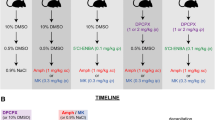Abstract
The effect of the selective adenosine A1 receptor agonist 2-chloro-N 6-cyclopentyladenosine (CCPA) was investigated in CD1 mice by the elevated plus-maze and the light/dark test, two models for measuring anxiety in rodents. CCPA, administered IP, had an anxiolytic effect at 0.3 nmol/kg in the elevated plus-maze and at 1 nmol/kg in the light/dark test. Brain levels of 22 nM were found after administration of 100 nmol/kg CCPA, as measured by ex vivo binding experiments. These values are consistent with the occupancy of adenosine A1 but not A2 receptors by CCPA, and suggest that the anxiolytic-like action of CCPA may be mediated by centrally located adenosine A1 receptors. Both CPT, a selective adenosine A1 receptor antagonist, and IBMX, a non-selective adenosine antagonist, had an anxiogenic effect in the two tests. It is thus possible that purinergic neurons may be involved in the tonic modulation of affective state in mice.
Similar content being viewed by others
Author information
Authors and Affiliations
Additional information
Received: 4 March 1997/Final version: 4 October 1997
Rights and permissions
About this article
Cite this article
Florio, C., Prezioso, A., Papaioannou, A. et al. Adenosine A1 receptors modulate anxiety in CD1 mice. Psychopharmacology 136, 311–319 (1998). https://doi.org/10.1007/s002130050572
Issue Date:
DOI: https://doi.org/10.1007/s002130050572




